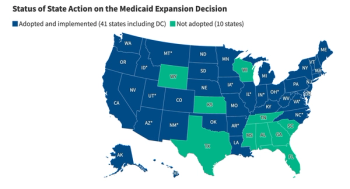
Achieving technology goals appears within reach
New technologies have lifecycles that include a curve of initial resistance as well as an eventual plateau of acceptance. There are some who rush out and buy the latest gadget the minute it's available, and others—myself included—who wait to see how the new product or service pans out. Some of us cling to our old ways and our comfortable devices because we're used to them or because they're so much less expensive. At some point in time, however, we resisters just have to give in.
New technologies have lifecycles that include a curve of initial resistance as well as an eventual plateau of acceptance. There are some who rush out and buy the latest gadget the minute it's available, and others-myself included-who wait to see how the new product or service pans out. Some of us cling to our old ways and our comfortable devices because we're used to them or because they're so much less expensive. At some point in time, however, we resisters just have to give in.
Take, for example, television. My only TV is one that's not equipped for digital broadcast. As the country converts to all-digital formats, I'm going to have to buy a new TV or at least a fancy converter box. I guess that will also eliminate my last excuse for not signing up for cable. As I understand it, the full digital conversion is scheduled to be completed by the end of 2006, and resisters like me will have to turn in our faithful rabbit ears.
President Bush has set 2014 as the year in which most Americans should have access to interoperable health records. Resistant providers will have to let go of their paper charts and adopt electronic ones. You've probably noticed the industry is reporting much greater acceptance among providers lately, and I believe some of that is due to cooperative strategies. Datamonitor reports that providers will spend up to $39.5 billion on IT in the next two years. Yes, the resisters are still out there, understandably, but their numbers are decreasing.
Regional health information organizations (RHIOs), which are supported by the federal government, private organizations and states, are slowly rolling out across the country. The participants put their information together and share health records for the people they serve as patients and plan members. As the regional infrastructures progress, participants will also need to create a sustainable business model to keep the organizations operating once the initial funding dries up.
After years of planning, a group of payers and providers in Colorado has completed the launch of its RHIO, the Integrated Physician Network Avista. This clever group has also taken its purpose a step further, beyond just the electronic data sharing initiative, to include increased access to health services for the local community. The private physicians that are involved in the network have also agreed to open their panels to the uninsured and those in Medicare and Medicaid.
Now that they have access to demographics, referrals, medications, allergies, lab reports and notes, doctors can treat these underserved patients more efficiently and more cost-effectively. Previously, according to the RHIO's participants, it was just too financially risky to accept these patients.
According to Doug Bach, chief information officer for participating health plan Colorado Access, the RHIO is "a physician led project with physicians funding $1.5 million of their own money to create the organization. This commitment to improving patient care is admirable."
It's an exciting time. We're creeping forward on that initial adoption curve, and we have the mind to make a lot of progress. I've been struggling to decide for myself whether or not the President's 2014 deadline is an attainable goal. The more I hear about the successful RHIO launches, the more I think we're going to be able to get it done. Who knows: One day I might be able to curl up on the couch and tune into my own health record on my digital television.
Julie Miller is editor-in-chief of MANAGED HEALTHCARE EXECUTIVE. She can be reached at
Newsletter
Get the latest industry news, event updates, and more from Managed healthcare Executive.






















































